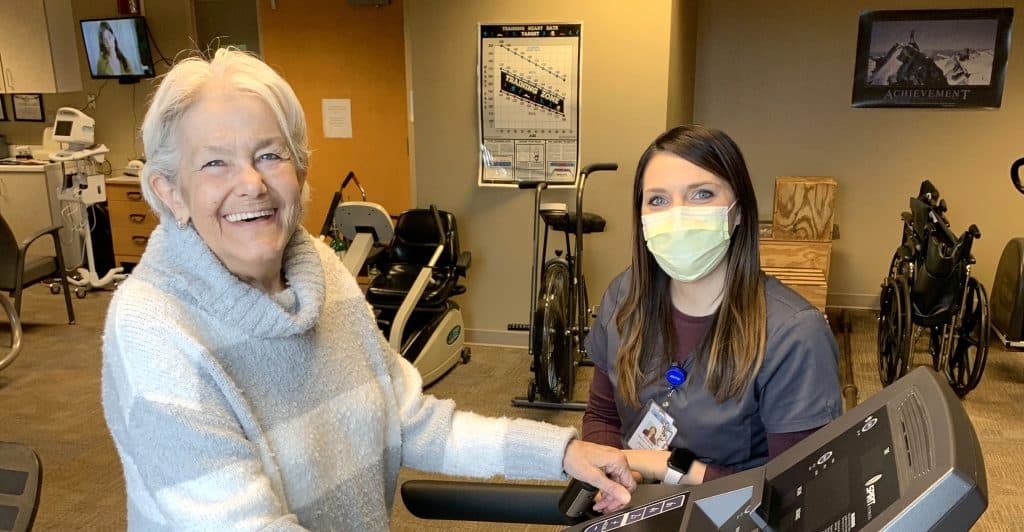Living with a lung disease was restricting and defining Donna Simon’s way of life. Although she had just renewed her license, she stopped driving (for fear of causing an accident), stopped shopping for groceries, going to sporting events, even taking care of her grandkids. She was basically staying at home and only going out to go to doctor appointments. As a mother who raised seven children, four of whom participated in the Dubuque Colt’s Drum and Bugle Corp, it was a sad day when she couldn’t go see a local performance with her daughter. Donna had been oxygen-dependent for over three years, and it was robbing her of the life she knew.
Donna came to GMHC for pulmonary rehab to see what breathing she could regain. Respiratory Therapist Amanda Miller, noted that during Donna’s therapy sessions her oxygen levels would drop immediately, causing severe shortness of breath and increasing her heart rate and blood pressure. This is typical for patients with lung disease, but the progress they had hoped to make just wasn’t happening. In fact, it was all they could do just to maintain her current level of breathing. Her lungs were in a serious condition.
Donna had been a patient of Dr. Schope (now retired) in Dubuque, who had diagnosed her with COPD in 2012. Although she tried to quit smoking then, it took her until 2018 to stop for good. During a visit with her new pulmonologist, Dr. Powers, it was suggested that Donna might want to consider getting a lung transplant. She discussed it with her family and with the medical staff at GMHC, and everyone in both cases was supportive of that decision. It would not be an easy road, but she was willing to try it.
To be placed on the transplant list, Donna would have to undergo almost 6 months of testing. Dr. Hoffmann and Dr. Powers sent her records to the University of Iowa, and the testing began. She had to have a colonoscopy, CT scans, MRIs, and even a checkup with dermatology, among other tests. All her immunizations had to be up to date. There had to be absolutely no signs of cancer, skin or otherwise, because the medications taken for cancers could cause scarring in the lung and could also cause any existing cancer to grow more rapidly.
Saying that Donna was a trooper through all the testing and trips to Iowa City was probably an understatement, as she had to complete all of this while she still felt miserable and could hardly breathe. Finally, on August 10, 2020, she was put on the lung transplant list, and six months later, on February 25, 2021, she received her new lungs.
Immediately after surgery, a lung transplant patient is required to stay in Iowa City for intensive care and therapy before they can leave the hospital. Following this first round of therapy, she was transferred to St. Luke’s in-patient rehab department in Cedar Rapids. After a reaction to a medication, she had to return to UIHC for two weeks before completing her therapy at St. Luke’s, where she remained until they were able to get her up and walking. After this accomplishment, she was able to return home to Guttenberg with her husband and dog! She began pulmonary rehabilitative therapy here at GMHC. She commented, “That was huge for me, to be able to come home and go to therapy nearby. It made such a difference in my recovery.”
Donna still needed to make some trips to Iowa City for post-surgery tests and checkups, but her doctor allowed her to do the frequent and necessary lab work at GMHC and have the information forwarded to U of I. “That made it much easier for me and saved us a lot of travel,” she commented. During her therapy at GMHC and recovery at home, Donna was sure to celebrate the little milestones along the way. At first, her husband had to help her get up out of the chair by lifting her at the back side of her pants waistband. “I got tired of all the wedgies he was giving me!” she joked. When she was finally able to complete this task alone, she announced, “Look at me, I can to this without anyone here!” And “I couldn’t have done this without the great rehab I was receiving.”
Donna had some work to do to regain her confidence in driving, as it had been 3 long years since she had been behind the wheel. But lately, she is taking full advantage of her newfound freedom. She is driving again, shopping for groceries, meeting friends for lunch and even driving herself to her appointments in Iowa City. Perhaps best of all, she recently was able to watch her grandkids again, and even made a trip to Redfield to celebrate birthdays for two of them. After seeing her for so long with an oxygen line attached, her grandson asked, “How are we going to be able to find you Grandma, without your cord?” When asked to describe how all of this makes her feel, she exclaimed, “It is great! It’s basically like having a new life!”
“We (Respiratory Therapy Staff) are very proud of Donna throughout her road to recovery. It was truly amazing to witness her reclaim her life and get back to being a busy grandma!” replied Amanda Miller, RT.



